Importance of Communication in Criminal Justice: A Reflective Essay
VerifiedAdded on 2023/04/22
|12
|3055
|438
AI Summary
This reflective essay focuses on the importance of communication in criminal justice and the nine principles of effective communication. It also discusses the six steps to produce papers and presentations and the approach to group work.
Contribute Materials
Your contribution can guide someone’s learning journey. Share your
documents today.

Running head: REFLECTIVE EASSY 1
REFLECTIVE EASSY 1
Name of the student:
Name of the university:
Author note:
REFLECTIVE EASSY 1
Name of the student:
Name of the university:
Author note:
Secure Best Marks with AI Grader
Need help grading? Try our AI Grader for instant feedback on your assignments.
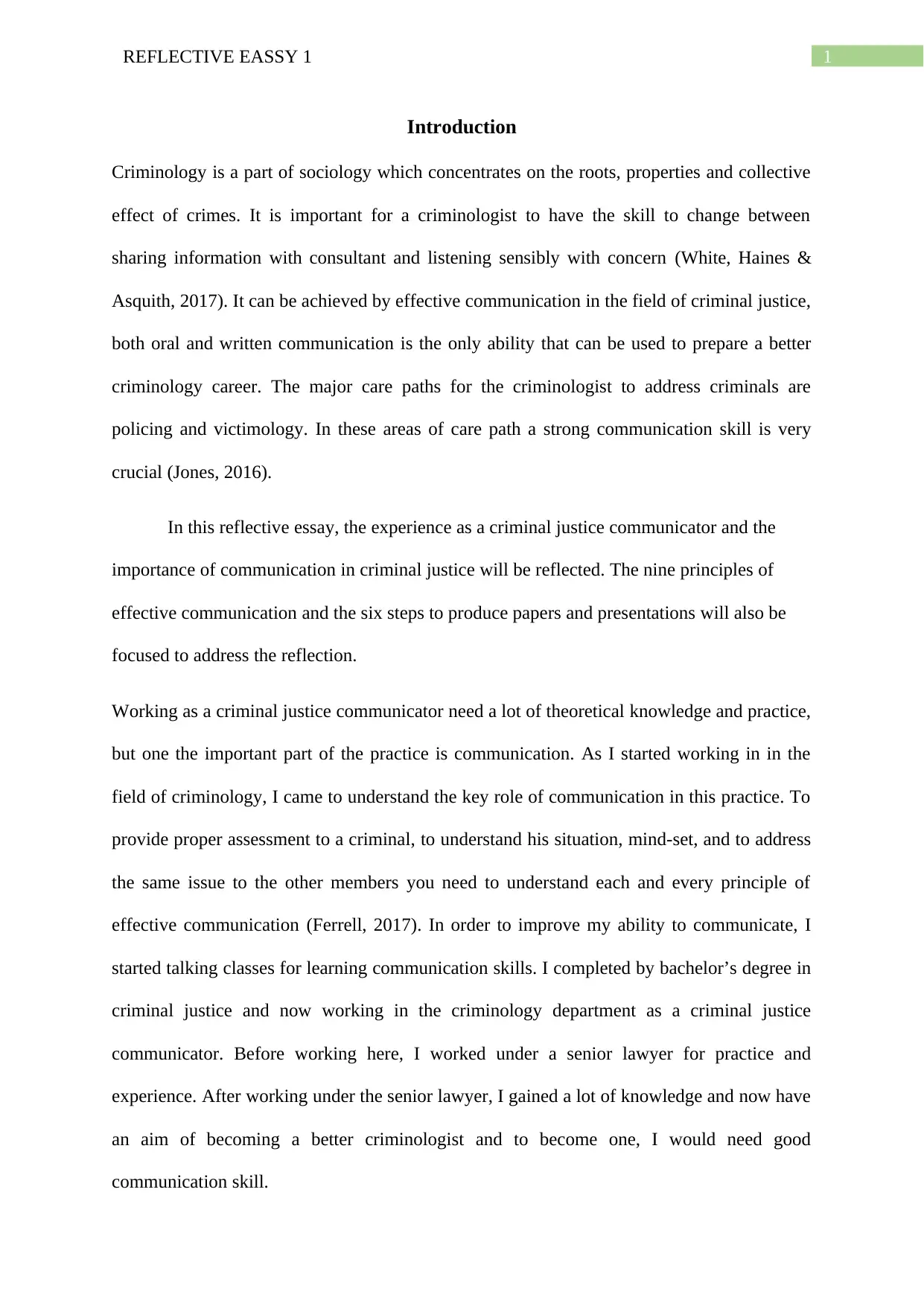
1REFLECTIVE EASSY 1
Introduction
Criminology is a part of sociology which concentrates on the roots, properties and collective
effect of crimes. It is important for a criminologist to have the skill to change between
sharing information with consultant and listening sensibly with concern (White, Haines &
Asquith, 2017). It can be achieved by effective communication in the field of criminal justice,
both oral and written communication is the only ability that can be used to prepare a better
criminology career. The major care paths for the criminologist to address criminals are
policing and victimology. In these areas of care path a strong communication skill is very
crucial (Jones, 2016).
In this reflective essay, the experience as a criminal justice communicator and the
importance of communication in criminal justice will be reflected. The nine principles of
effective communication and the six steps to produce papers and presentations will also be
focused to address the reflection.
Working as a criminal justice communicator need a lot of theoretical knowledge and practice,
but one the important part of the practice is communication. As I started working in in the
field of criminology, I came to understand the key role of communication in this practice. To
provide proper assessment to a criminal, to understand his situation, mind-set, and to address
the same issue to the other members you need to understand each and every principle of
effective communication (Ferrell, 2017). In order to improve my ability to communicate, I
started talking classes for learning communication skills. I completed by bachelor’s degree in
criminal justice and now working in the criminology department as a criminal justice
communicator. Before working here, I worked under a senior lawyer for practice and
experience. After working under the senior lawyer, I gained a lot of knowledge and now have
an aim of becoming a better criminologist and to become one, I would need good
communication skill.
Introduction
Criminology is a part of sociology which concentrates on the roots, properties and collective
effect of crimes. It is important for a criminologist to have the skill to change between
sharing information with consultant and listening sensibly with concern (White, Haines &
Asquith, 2017). It can be achieved by effective communication in the field of criminal justice,
both oral and written communication is the only ability that can be used to prepare a better
criminology career. The major care paths for the criminologist to address criminals are
policing and victimology. In these areas of care path a strong communication skill is very
crucial (Jones, 2016).
In this reflective essay, the experience as a criminal justice communicator and the
importance of communication in criminal justice will be reflected. The nine principles of
effective communication and the six steps to produce papers and presentations will also be
focused to address the reflection.
Working as a criminal justice communicator need a lot of theoretical knowledge and practice,
but one the important part of the practice is communication. As I started working in in the
field of criminology, I came to understand the key role of communication in this practice. To
provide proper assessment to a criminal, to understand his situation, mind-set, and to address
the same issue to the other members you need to understand each and every principle of
effective communication (Ferrell, 2017). In order to improve my ability to communicate, I
started talking classes for learning communication skills. I completed by bachelor’s degree in
criminal justice and now working in the criminology department as a criminal justice
communicator. Before working here, I worked under a senior lawyer for practice and
experience. After working under the senior lawyer, I gained a lot of knowledge and now have
an aim of becoming a better criminologist and to become one, I would need good
communication skill.

2REFLECTIVE EASSY 1
Nine principles
I was taught about these nine principles of effective communication and their application in
my practice, and it has help me in judging myself as a criminal justice communicator. The
nine principle of effective communication which is required to be followed (Eaves &
Leathers, 2017):
1. Professionalism: professionalism refers to certain characteristics in obtaining
technical competence. The technical competency has been found to convert a person
into a professional is respective field of work (Faucett et al., 2018). And to gain
professionalism in me I would need to keep my emotions aside and make decisions
and perform my work in a manner that would benefit the organisation and favour
justice for the criminal. So I would rate myself 3 out of 10 as I have found myself
emotionally weak as I get emotionally attached to the person requiring justice.
2. Responsiveness: speaking its objective, following to all parameters, and target the
audience(s) (Chang & Tang, 2015). Following the principle, I have become a better
communicator as I have learnt to follow all parameters while handling a criminal,
focusing on their point and understanding and providing proper assistance. so I would
like to score myself 9 out of 10.
3. Organization: Preparation of information in a way that would better help the
communication attain its purpose. as a criminal justice communicator (Koch, 2016). I
keep all the issues and objectives about my client and the case in mind and arrange the
case study accordingly, so that it becomes easy for the judge to understand it in a
better way. So according to my judgement, I would rate myself 8 out of 10.
4. Logic: this principle focuses on reasoning strategy to reach any conclusion, and to
input the principle in account, a lot of practice is required as it’s all about complex
assessment and judgment procedure, so at this stage I would rate myself 6 out of 10 as
Nine principles
I was taught about these nine principles of effective communication and their application in
my practice, and it has help me in judging myself as a criminal justice communicator. The
nine principle of effective communication which is required to be followed (Eaves &
Leathers, 2017):
1. Professionalism: professionalism refers to certain characteristics in obtaining
technical competence. The technical competency has been found to convert a person
into a professional is respective field of work (Faucett et al., 2018). And to gain
professionalism in me I would need to keep my emotions aside and make decisions
and perform my work in a manner that would benefit the organisation and favour
justice for the criminal. So I would rate myself 3 out of 10 as I have found myself
emotionally weak as I get emotionally attached to the person requiring justice.
2. Responsiveness: speaking its objective, following to all parameters, and target the
audience(s) (Chang & Tang, 2015). Following the principle, I have become a better
communicator as I have learnt to follow all parameters while handling a criminal,
focusing on their point and understanding and providing proper assistance. so I would
like to score myself 9 out of 10.
3. Organization: Preparation of information in a way that would better help the
communication attain its purpose. as a criminal justice communicator (Koch, 2016). I
keep all the issues and objectives about my client and the case in mind and arrange the
case study accordingly, so that it becomes easy for the judge to understand it in a
better way. So according to my judgement, I would rate myself 8 out of 10.
4. Logic: this principle focuses on reasoning strategy to reach any conclusion, and to
input the principle in account, a lot of practice is required as it’s all about complex
assessment and judgment procedure, so at this stage I would rate myself 6 out of 10 as
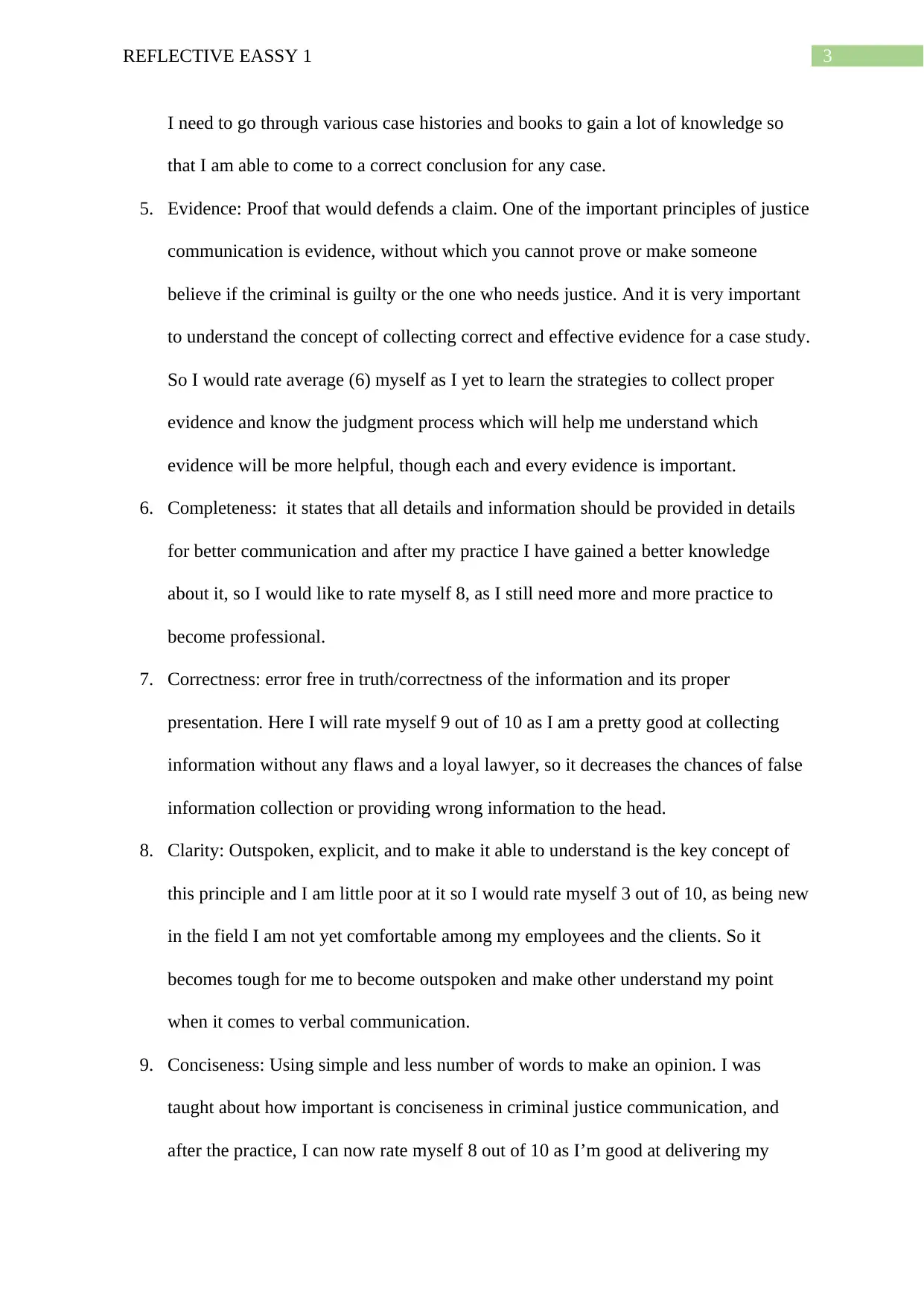
3REFLECTIVE EASSY 1
I need to go through various case histories and books to gain a lot of knowledge so
that I am able to come to a correct conclusion for any case.
5. Evidence: Proof that would defends a claim. One of the important principles of justice
communication is evidence, without which you cannot prove or make someone
believe if the criminal is guilty or the one who needs justice. And it is very important
to understand the concept of collecting correct and effective evidence for a case study.
So I would rate average (6) myself as I yet to learn the strategies to collect proper
evidence and know the judgment process which will help me understand which
evidence will be more helpful, though each and every evidence is important.
6. Completeness: it states that all details and information should be provided in details
for better communication and after my practice I have gained a better knowledge
about it, so I would like to rate myself 8, as I still need more and more practice to
become professional.
7. Correctness: error free in truth/correctness of the information and its proper
presentation. Here I will rate myself 9 out of 10 as I am a pretty good at collecting
information without any flaws and a loyal lawyer, so it decreases the chances of false
information collection or providing wrong information to the head.
8. Clarity: Outspoken, explicit, and to make it able to understand is the key concept of
this principle and I am little poor at it so I would rate myself 3 out of 10, as being new
in the field I am not yet comfortable among my employees and the clients. So it
becomes tough for me to become outspoken and make other understand my point
when it comes to verbal communication.
9. Conciseness: Using simple and less number of words to make an opinion. I was
taught about how important is conciseness in criminal justice communication, and
after the practice, I can now rate myself 8 out of 10 as I’m good at delivering my
I need to go through various case histories and books to gain a lot of knowledge so
that I am able to come to a correct conclusion for any case.
5. Evidence: Proof that would defends a claim. One of the important principles of justice
communication is evidence, without which you cannot prove or make someone
believe if the criminal is guilty or the one who needs justice. And it is very important
to understand the concept of collecting correct and effective evidence for a case study.
So I would rate average (6) myself as I yet to learn the strategies to collect proper
evidence and know the judgment process which will help me understand which
evidence will be more helpful, though each and every evidence is important.
6. Completeness: it states that all details and information should be provided in details
for better communication and after my practice I have gained a better knowledge
about it, so I would like to rate myself 8, as I still need more and more practice to
become professional.
7. Correctness: error free in truth/correctness of the information and its proper
presentation. Here I will rate myself 9 out of 10 as I am a pretty good at collecting
information without any flaws and a loyal lawyer, so it decreases the chances of false
information collection or providing wrong information to the head.
8. Clarity: Outspoken, explicit, and to make it able to understand is the key concept of
this principle and I am little poor at it so I would rate myself 3 out of 10, as being new
in the field I am not yet comfortable among my employees and the clients. So it
becomes tough for me to become outspoken and make other understand my point
when it comes to verbal communication.
9. Conciseness: Using simple and less number of words to make an opinion. I was
taught about how important is conciseness in criminal justice communication, and
after the practice, I can now rate myself 8 out of 10 as I’m good at delivering my
Secure Best Marks with AI Grader
Need help grading? Try our AI Grader for instant feedback on your assignments.
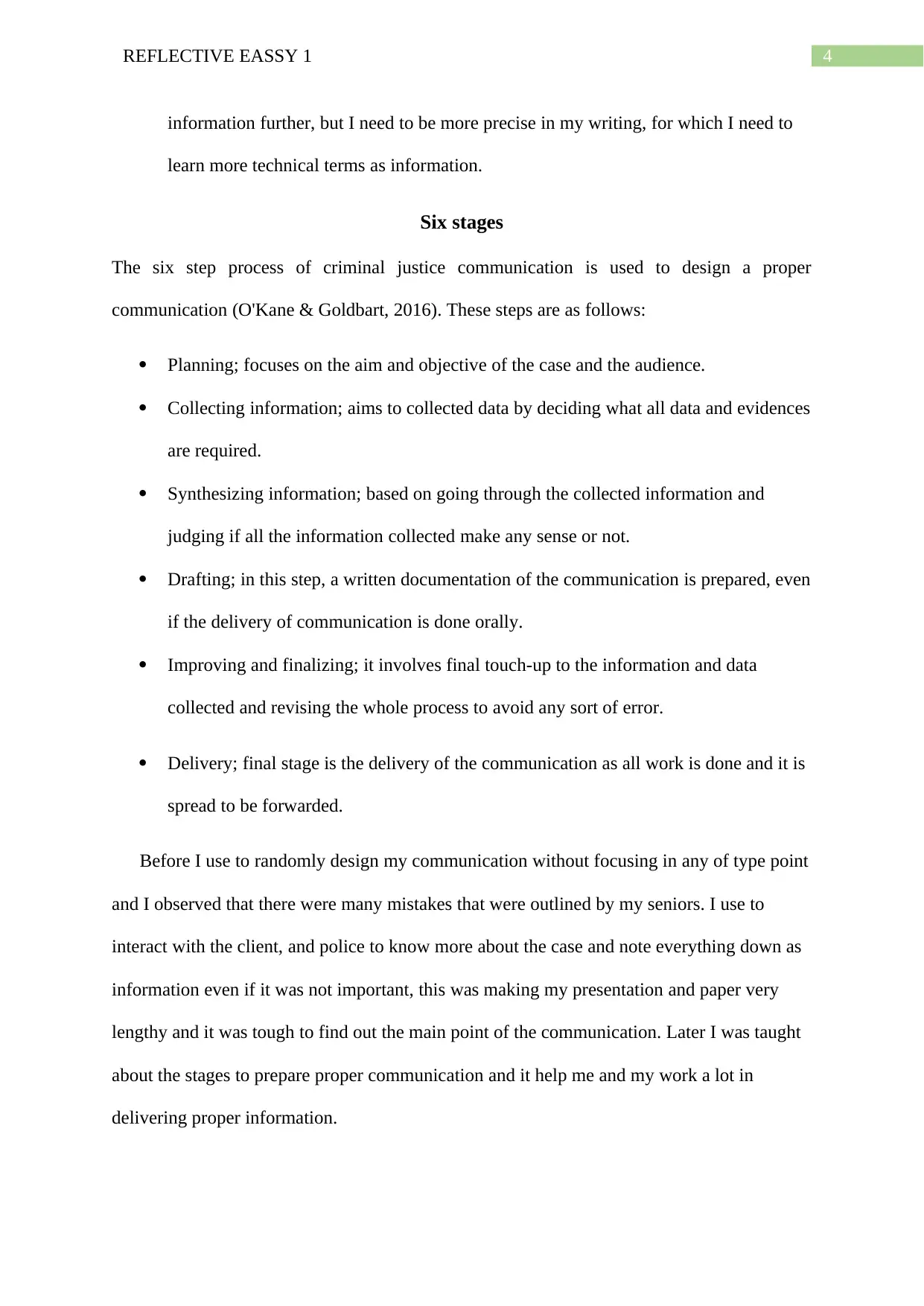
4REFLECTIVE EASSY 1
information further, but I need to be more precise in my writing, for which I need to
learn more technical terms as information.
Six stages
The six step process of criminal justice communication is used to design a proper
communication (O'Kane & Goldbart, 2016). These steps are as follows:
Planning; focuses on the aim and objective of the case and the audience.
Collecting information; aims to collected data by deciding what all data and evidences
are required.
Synthesizing information; based on going through the collected information and
judging if all the information collected make any sense or not.
Drafting; in this step, a written documentation of the communication is prepared, even
if the delivery of communication is done orally.
Improving and finalizing; it involves final touch-up to the information and data
collected and revising the whole process to avoid any sort of error.
Delivery; final stage is the delivery of the communication as all work is done and it is
spread to be forwarded.
Before I use to randomly design my communication without focusing in any of type point
and I observed that there were many mistakes that were outlined by my seniors. I use to
interact with the client, and police to know more about the case and note everything down as
information even if it was not important, this was making my presentation and paper very
lengthy and it was tough to find out the main point of the communication. Later I was taught
about the stages to prepare proper communication and it help me and my work a lot in
delivering proper information.
information further, but I need to be more precise in my writing, for which I need to
learn more technical terms as information.
Six stages
The six step process of criminal justice communication is used to design a proper
communication (O'Kane & Goldbart, 2016). These steps are as follows:
Planning; focuses on the aim and objective of the case and the audience.
Collecting information; aims to collected data by deciding what all data and evidences
are required.
Synthesizing information; based on going through the collected information and
judging if all the information collected make any sense or not.
Drafting; in this step, a written documentation of the communication is prepared, even
if the delivery of communication is done orally.
Improving and finalizing; it involves final touch-up to the information and data
collected and revising the whole process to avoid any sort of error.
Delivery; final stage is the delivery of the communication as all work is done and it is
spread to be forwarded.
Before I use to randomly design my communication without focusing in any of type point
and I observed that there were many mistakes that were outlined by my seniors. I use to
interact with the client, and police to know more about the case and note everything down as
information even if it was not important, this was making my presentation and paper very
lengthy and it was tough to find out the main point of the communication. Later I was taught
about the stages to prepare proper communication and it help me and my work a lot in
delivering proper information.
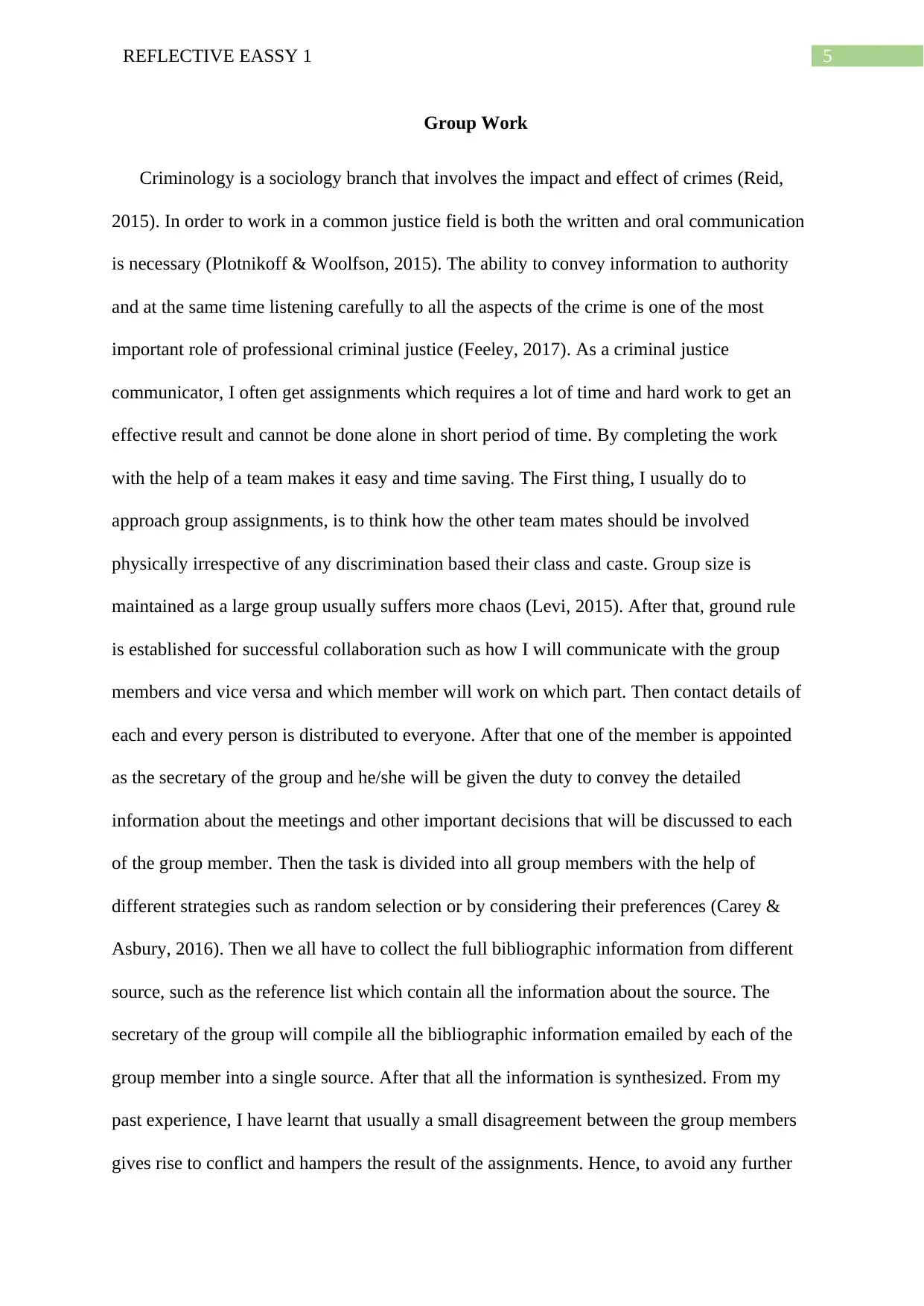
5REFLECTIVE EASSY 1
Group Work
Criminology is a sociology branch that involves the impact and effect of crimes (Reid,
2015). In order to work in a common justice field is both the written and oral communication
is necessary (Plotnikoff & Woolfson, 2015). The ability to convey information to authority
and at the same time listening carefully to all the aspects of the crime is one of the most
important role of professional criminal justice (Feeley, 2017). As a criminal justice
communicator, I often get assignments which requires a lot of time and hard work to get an
effective result and cannot be done alone in short period of time. By completing the work
with the help of a team makes it easy and time saving. The First thing, I usually do to
approach group assignments, is to think how the other team mates should be involved
physically irrespective of any discrimination based their class and caste. Group size is
maintained as a large group usually suffers more chaos (Levi, 2015). After that, ground rule
is established for successful collaboration such as how I will communicate with the group
members and vice versa and which member will work on which part. Then contact details of
each and every person is distributed to everyone. After that one of the member is appointed
as the secretary of the group and he/she will be given the duty to convey the detailed
information about the meetings and other important decisions that will be discussed to each
of the group member. Then the task is divided into all group members with the help of
different strategies such as random selection or by considering their preferences (Carey &
Asbury, 2016). Then we all have to collect the full bibliographic information from different
source, such as the reference list which contain all the information about the source. The
secretary of the group will compile all the bibliographic information emailed by each of the
group member into a single source. After that all the information is synthesized. From my
past experience, I have learnt that usually a small disagreement between the group members
gives rise to conflict and hampers the result of the assignments. Hence, to avoid any further
Group Work
Criminology is a sociology branch that involves the impact and effect of crimes (Reid,
2015). In order to work in a common justice field is both the written and oral communication
is necessary (Plotnikoff & Woolfson, 2015). The ability to convey information to authority
and at the same time listening carefully to all the aspects of the crime is one of the most
important role of professional criminal justice (Feeley, 2017). As a criminal justice
communicator, I often get assignments which requires a lot of time and hard work to get an
effective result and cannot be done alone in short period of time. By completing the work
with the help of a team makes it easy and time saving. The First thing, I usually do to
approach group assignments, is to think how the other team mates should be involved
physically irrespective of any discrimination based their class and caste. Group size is
maintained as a large group usually suffers more chaos (Levi, 2015). After that, ground rule
is established for successful collaboration such as how I will communicate with the group
members and vice versa and which member will work on which part. Then contact details of
each and every person is distributed to everyone. After that one of the member is appointed
as the secretary of the group and he/she will be given the duty to convey the detailed
information about the meetings and other important decisions that will be discussed to each
of the group member. Then the task is divided into all group members with the help of
different strategies such as random selection or by considering their preferences (Carey &
Asbury, 2016). Then we all have to collect the full bibliographic information from different
source, such as the reference list which contain all the information about the source. The
secretary of the group will compile all the bibliographic information emailed by each of the
group member into a single source. After that all the information is synthesized. From my
past experience, I have learnt that usually a small disagreement between the group members
gives rise to conflict and hampers the result of the assignments. Hence, to avoid any further
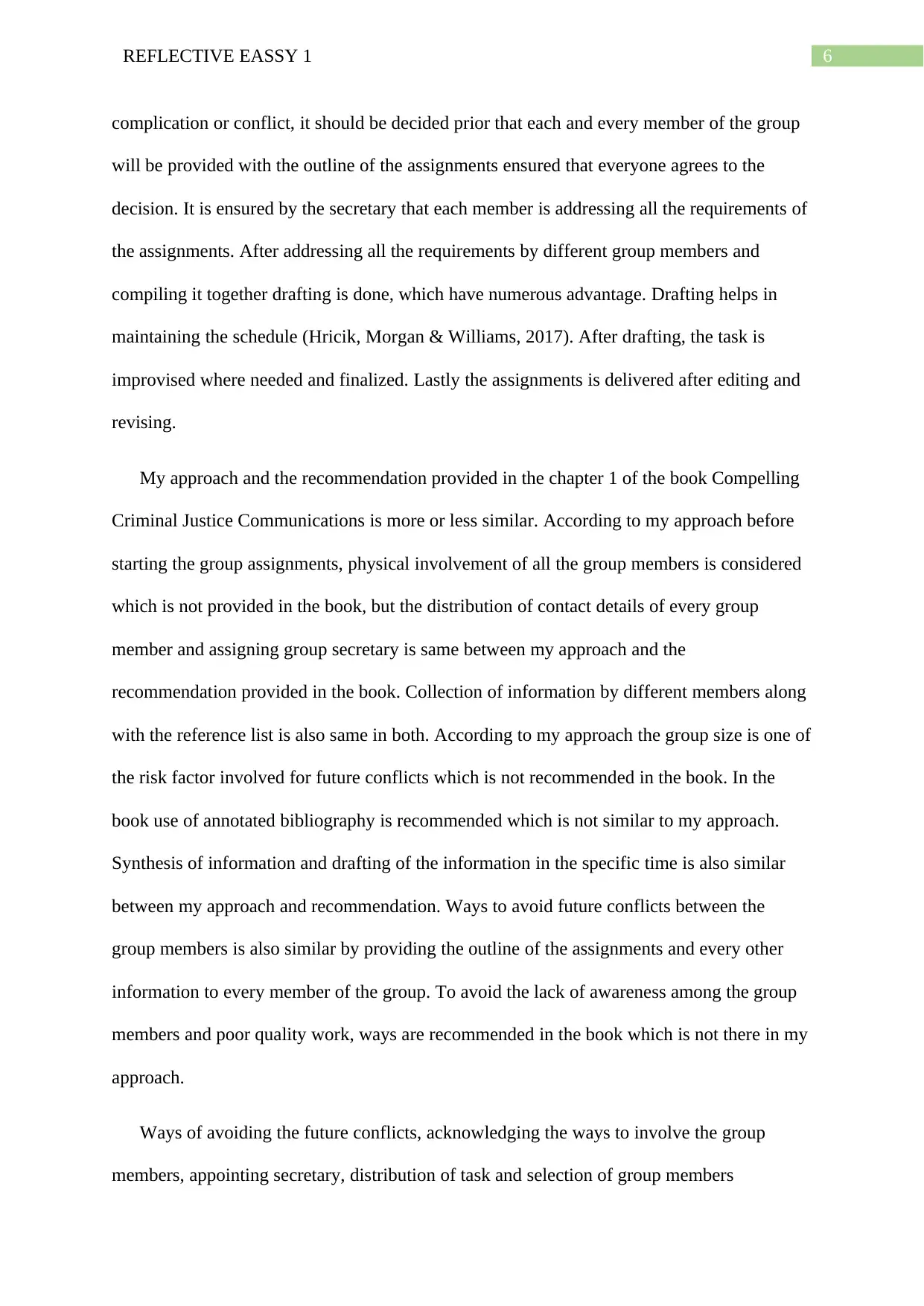
6REFLECTIVE EASSY 1
complication or conflict, it should be decided prior that each and every member of the group
will be provided with the outline of the assignments ensured that everyone agrees to the
decision. It is ensured by the secretary that each member is addressing all the requirements of
the assignments. After addressing all the requirements by different group members and
compiling it together drafting is done, which have numerous advantage. Drafting helps in
maintaining the schedule (Hricik, Morgan & Williams, 2017). After drafting, the task is
improvised where needed and finalized. Lastly the assignments is delivered after editing and
revising.
My approach and the recommendation provided in the chapter 1 of the book Compelling
Criminal Justice Communications is more or less similar. According to my approach before
starting the group assignments, physical involvement of all the group members is considered
which is not provided in the book, but the distribution of contact details of every group
member and assigning group secretary is same between my approach and the
recommendation provided in the book. Collection of information by different members along
with the reference list is also same in both. According to my approach the group size is one of
the risk factor involved for future conflicts which is not recommended in the book. In the
book use of annotated bibliography is recommended which is not similar to my approach.
Synthesis of information and drafting of the information in the specific time is also similar
between my approach and recommendation. Ways to avoid future conflicts between the
group members is also similar by providing the outline of the assignments and every other
information to every member of the group. To avoid the lack of awareness among the group
members and poor quality work, ways are recommended in the book which is not there in my
approach.
Ways of avoiding the future conflicts, acknowledging the ways to involve the group
members, appointing secretary, distribution of task and selection of group members
complication or conflict, it should be decided prior that each and every member of the group
will be provided with the outline of the assignments ensured that everyone agrees to the
decision. It is ensured by the secretary that each member is addressing all the requirements of
the assignments. After addressing all the requirements by different group members and
compiling it together drafting is done, which have numerous advantage. Drafting helps in
maintaining the schedule (Hricik, Morgan & Williams, 2017). After drafting, the task is
improvised where needed and finalized. Lastly the assignments is delivered after editing and
revising.
My approach and the recommendation provided in the chapter 1 of the book Compelling
Criminal Justice Communications is more or less similar. According to my approach before
starting the group assignments, physical involvement of all the group members is considered
which is not provided in the book, but the distribution of contact details of every group
member and assigning group secretary is same between my approach and the
recommendation provided in the book. Collection of information by different members along
with the reference list is also same in both. According to my approach the group size is one of
the risk factor involved for future conflicts which is not recommended in the book. In the
book use of annotated bibliography is recommended which is not similar to my approach.
Synthesis of information and drafting of the information in the specific time is also similar
between my approach and recommendation. Ways to avoid future conflicts between the
group members is also similar by providing the outline of the assignments and every other
information to every member of the group. To avoid the lack of awareness among the group
members and poor quality work, ways are recommended in the book which is not there in my
approach.
Ways of avoiding the future conflicts, acknowledging the ways to involve the group
members, appointing secretary, distribution of task and selection of group members
Paraphrase This Document
Need a fresh take? Get an instant paraphrase of this document with our AI Paraphraser
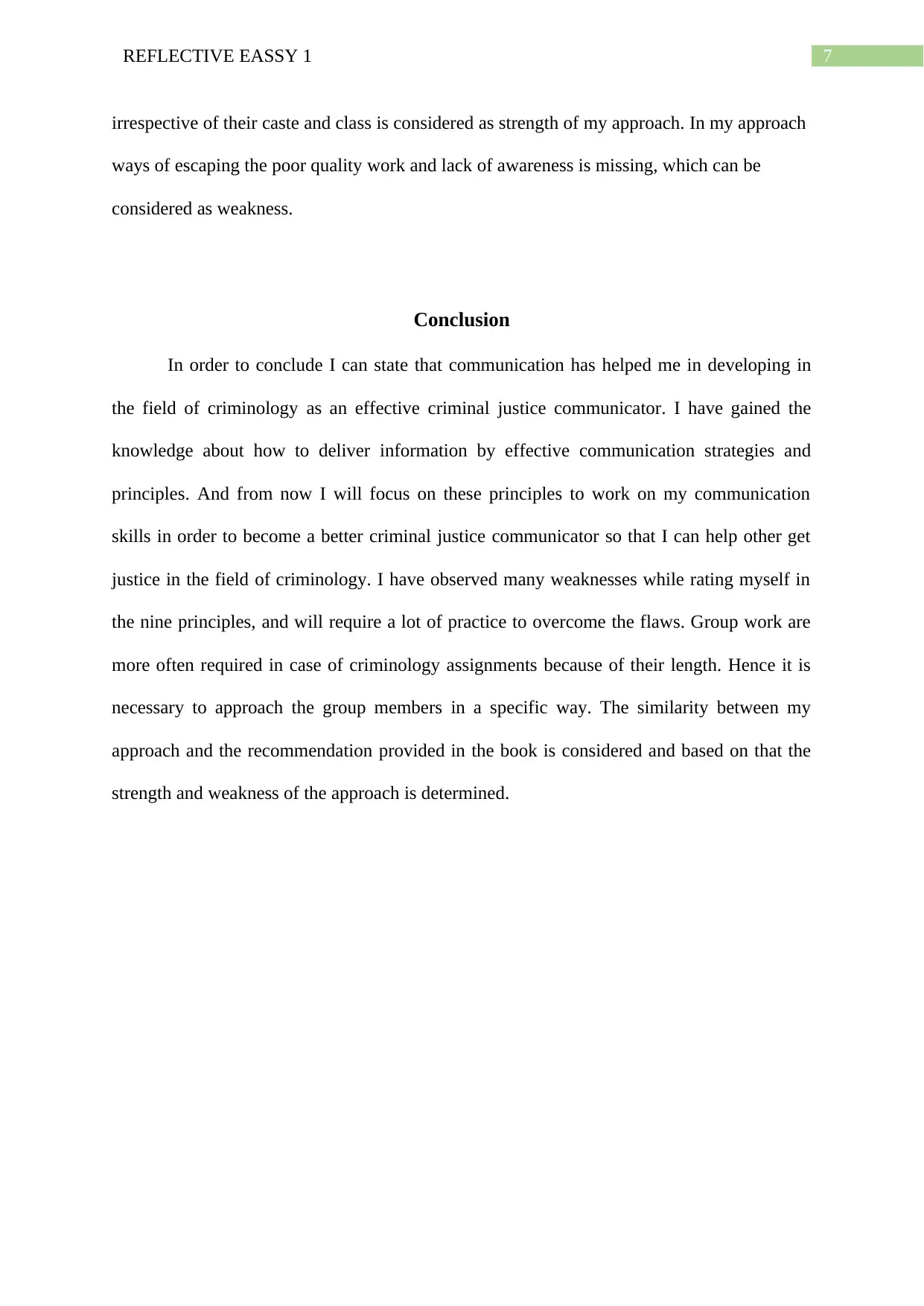
7REFLECTIVE EASSY 1
irrespective of their caste and class is considered as strength of my approach. In my approach
ways of escaping the poor quality work and lack of awareness is missing, which can be
considered as weakness.
Conclusion
In order to conclude I can state that communication has helped me in developing in
the field of criminology as an effective criminal justice communicator. I have gained the
knowledge about how to deliver information by effective communication strategies and
principles. And from now I will focus on these principles to work on my communication
skills in order to become a better criminal justice communicator so that I can help other get
justice in the field of criminology. I have observed many weaknesses while rating myself in
the nine principles, and will require a lot of practice to overcome the flaws. Group work are
more often required in case of criminology assignments because of their length. Hence it is
necessary to approach the group members in a specific way. The similarity between my
approach and the recommendation provided in the book is considered and based on that the
strength and weakness of the approach is determined.
irrespective of their caste and class is considered as strength of my approach. In my approach
ways of escaping the poor quality work and lack of awareness is missing, which can be
considered as weakness.
Conclusion
In order to conclude I can state that communication has helped me in developing in
the field of criminology as an effective criminal justice communicator. I have gained the
knowledge about how to deliver information by effective communication strategies and
principles. And from now I will focus on these principles to work on my communication
skills in order to become a better criminal justice communicator so that I can help other get
justice in the field of criminology. I have observed many weaknesses while rating myself in
the nine principles, and will require a lot of practice to overcome the flaws. Group work are
more often required in case of criminology assignments because of their length. Hence it is
necessary to approach the group members in a specific way. The similarity between my
approach and the recommendation provided in the book is considered and based on that the
strength and weakness of the approach is determined.
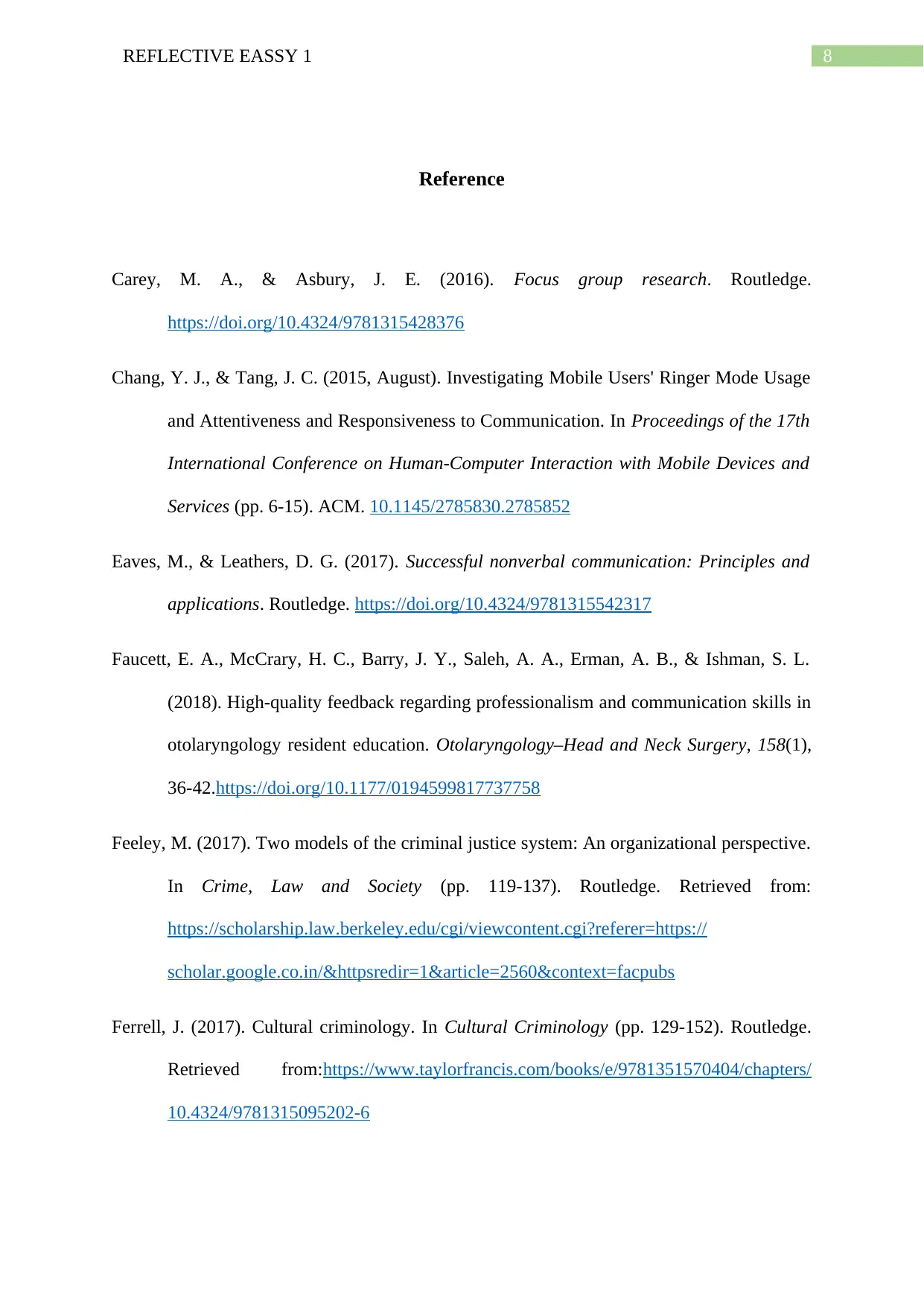
8REFLECTIVE EASSY 1
Reference
Carey, M. A., & Asbury, J. E. (2016). Focus group research. Routledge.
https://doi.org/10.4324/9781315428376
Chang, Y. J., & Tang, J. C. (2015, August). Investigating Mobile Users' Ringer Mode Usage
and Attentiveness and Responsiveness to Communication. In Proceedings of the 17th
International Conference on Human-Computer Interaction with Mobile Devices and
Services (pp. 6-15). ACM. 10.1145/2785830.2785852
Eaves, M., & Leathers, D. G. (2017). Successful nonverbal communication: Principles and
applications. Routledge. https://doi.org/10.4324/9781315542317
Faucett, E. A., McCrary, H. C., Barry, J. Y., Saleh, A. A., Erman, A. B., & Ishman, S. L.
(2018). High-quality feedback regarding professionalism and communication skills in
otolaryngology resident education. Otolaryngology–Head and Neck Surgery, 158(1),
36-42.https://doi.org/10.1177/0194599817737758
Feeley, M. (2017). Two models of the criminal justice system: An organizational perspective.
In Crime, Law and Society (pp. 119-137). Routledge. Retrieved from:
https://scholarship.law.berkeley.edu/cgi/viewcontent.cgi?referer=https://
scholar.google.co.in/&httpsredir=1&article=2560&context=facpubs
Ferrell, J. (2017). Cultural criminology. In Cultural Criminology (pp. 129-152). Routledge.
Retrieved from:https://www.taylorfrancis.com/books/e/9781351570404/chapters/
10.4324/9781315095202-6
Reference
Carey, M. A., & Asbury, J. E. (2016). Focus group research. Routledge.
https://doi.org/10.4324/9781315428376
Chang, Y. J., & Tang, J. C. (2015, August). Investigating Mobile Users' Ringer Mode Usage
and Attentiveness and Responsiveness to Communication. In Proceedings of the 17th
International Conference on Human-Computer Interaction with Mobile Devices and
Services (pp. 6-15). ACM. 10.1145/2785830.2785852
Eaves, M., & Leathers, D. G. (2017). Successful nonverbal communication: Principles and
applications. Routledge. https://doi.org/10.4324/9781315542317
Faucett, E. A., McCrary, H. C., Barry, J. Y., Saleh, A. A., Erman, A. B., & Ishman, S. L.
(2018). High-quality feedback regarding professionalism and communication skills in
otolaryngology resident education. Otolaryngology–Head and Neck Surgery, 158(1),
36-42.https://doi.org/10.1177/0194599817737758
Feeley, M. (2017). Two models of the criminal justice system: An organizational perspective.
In Crime, Law and Society (pp. 119-137). Routledge. Retrieved from:
https://scholarship.law.berkeley.edu/cgi/viewcontent.cgi?referer=https://
scholar.google.co.in/&httpsredir=1&article=2560&context=facpubs
Ferrell, J. (2017). Cultural criminology. In Cultural Criminology (pp. 129-152). Routledge.
Retrieved from:https://www.taylorfrancis.com/books/e/9781351570404/chapters/
10.4324/9781315095202-6
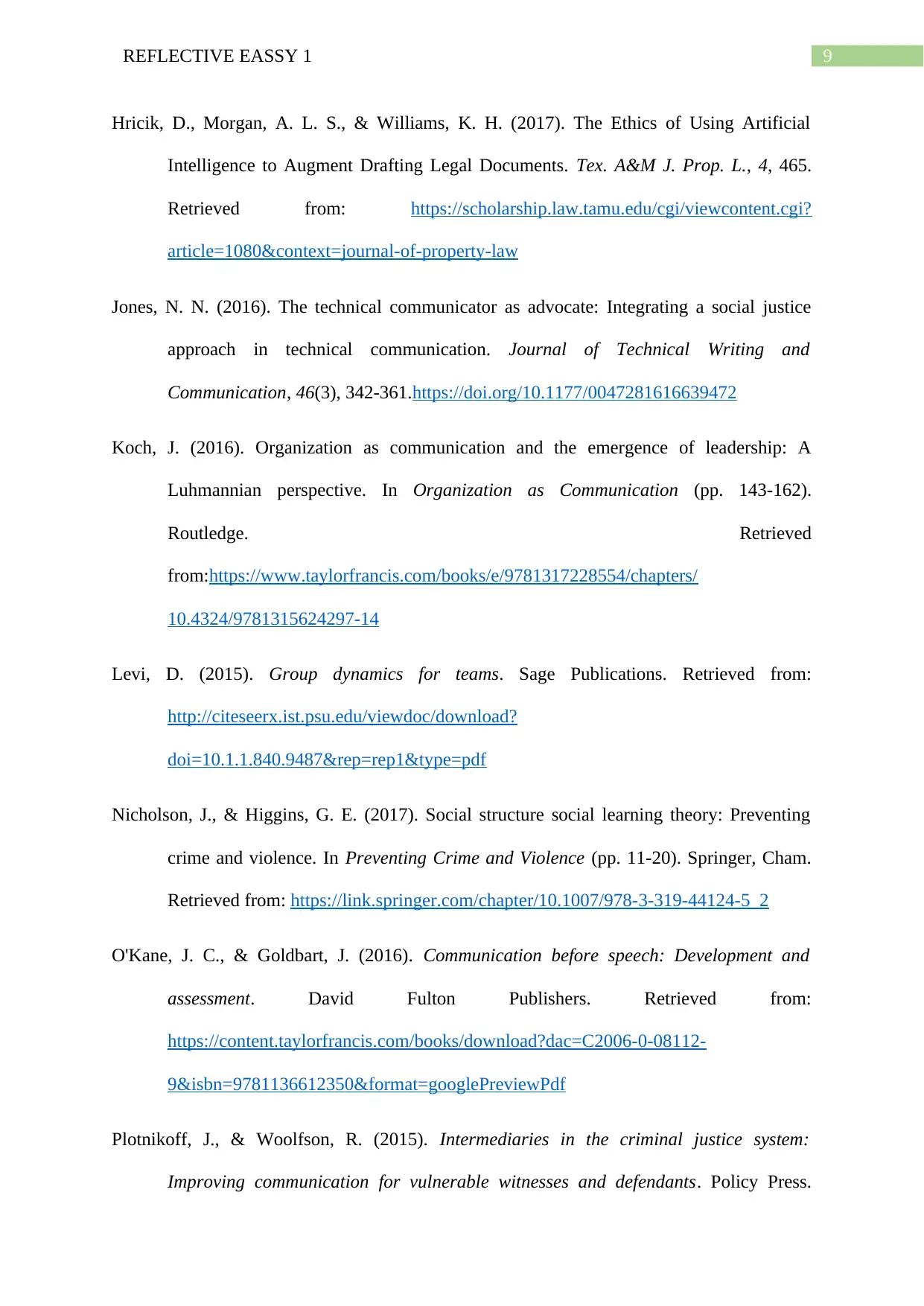
9REFLECTIVE EASSY 1
Hricik, D., Morgan, A. L. S., & Williams, K. H. (2017). The Ethics of Using Artificial
Intelligence to Augment Drafting Legal Documents. Tex. A&M J. Prop. L., 4, 465.
Retrieved from: https://scholarship.law.tamu.edu/cgi/viewcontent.cgi?
article=1080&context=journal-of-property-law
Jones, N. N. (2016). The technical communicator as advocate: Integrating a social justice
approach in technical communication. Journal of Technical Writing and
Communication, 46(3), 342-361.https://doi.org/10.1177/0047281616639472
Koch, J. (2016). Organization as communication and the emergence of leadership: A
Luhmannian perspective. In Organization as Communication (pp. 143-162).
Routledge. Retrieved
from:https://www.taylorfrancis.com/books/e/9781317228554/chapters/
10.4324/9781315624297-14
Levi, D. (2015). Group dynamics for teams. Sage Publications. Retrieved from:
http://citeseerx.ist.psu.edu/viewdoc/download?
doi=10.1.1.840.9487&rep=rep1&type=pdf
Nicholson, J., & Higgins, G. E. (2017). Social structure social learning theory: Preventing
crime and violence. In Preventing Crime and Violence (pp. 11-20). Springer, Cham.
Retrieved from: https://link.springer.com/chapter/10.1007/978-3-319-44124-5_2
O'Kane, J. C., & Goldbart, J. (2016). Communication before speech: Development and
assessment. David Fulton Publishers. Retrieved from:
https://content.taylorfrancis.com/books/download?dac=C2006-0-08112-
9&isbn=9781136612350&format=googlePreviewPdf
Plotnikoff, J., & Woolfson, R. (2015). Intermediaries in the criminal justice system:
Improving communication for vulnerable witnesses and defendants. Policy Press.
Hricik, D., Morgan, A. L. S., & Williams, K. H. (2017). The Ethics of Using Artificial
Intelligence to Augment Drafting Legal Documents. Tex. A&M J. Prop. L., 4, 465.
Retrieved from: https://scholarship.law.tamu.edu/cgi/viewcontent.cgi?
article=1080&context=journal-of-property-law
Jones, N. N. (2016). The technical communicator as advocate: Integrating a social justice
approach in technical communication. Journal of Technical Writing and
Communication, 46(3), 342-361.https://doi.org/10.1177/0047281616639472
Koch, J. (2016). Organization as communication and the emergence of leadership: A
Luhmannian perspective. In Organization as Communication (pp. 143-162).
Routledge. Retrieved
from:https://www.taylorfrancis.com/books/e/9781317228554/chapters/
10.4324/9781315624297-14
Levi, D. (2015). Group dynamics for teams. Sage Publications. Retrieved from:
http://citeseerx.ist.psu.edu/viewdoc/download?
doi=10.1.1.840.9487&rep=rep1&type=pdf
Nicholson, J., & Higgins, G. E. (2017). Social structure social learning theory: Preventing
crime and violence. In Preventing Crime and Violence (pp. 11-20). Springer, Cham.
Retrieved from: https://link.springer.com/chapter/10.1007/978-3-319-44124-5_2
O'Kane, J. C., & Goldbart, J. (2016). Communication before speech: Development and
assessment. David Fulton Publishers. Retrieved from:
https://content.taylorfrancis.com/books/download?dac=C2006-0-08112-
9&isbn=9781136612350&format=googlePreviewPdf
Plotnikoff, J., & Woolfson, R. (2015). Intermediaries in the criminal justice system:
Improving communication for vulnerable witnesses and defendants. Policy Press.
Secure Best Marks with AI Grader
Need help grading? Try our AI Grader for instant feedback on your assignments.
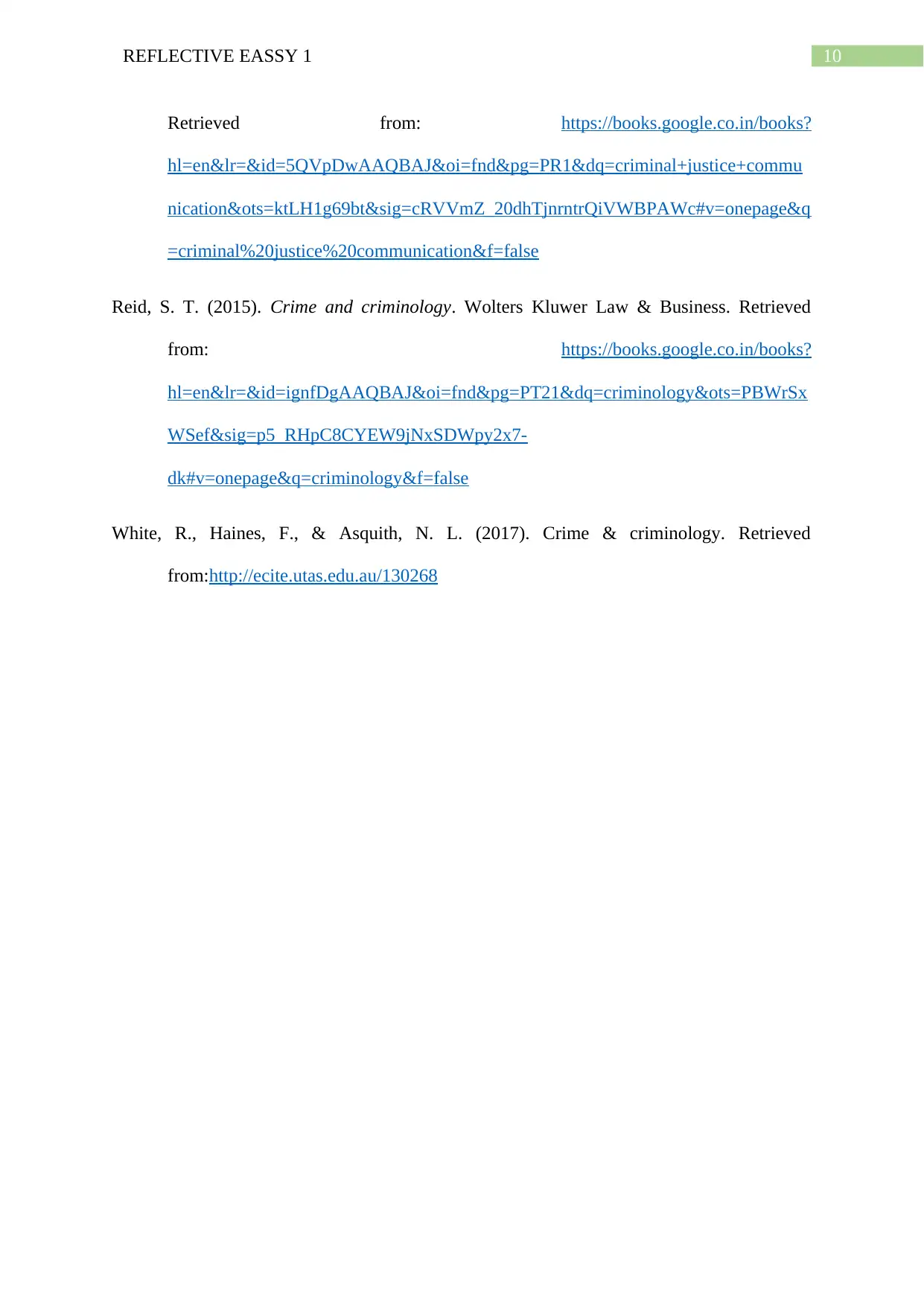
10REFLECTIVE EASSY 1
Retrieved from: https://books.google.co.in/books?
hl=en&lr=&id=5QVpDwAAQBAJ&oi=fnd&pg=PR1&dq=criminal+justice+commu
nication&ots=ktLH1g69bt&sig=cRVVmZ_20dhTjnrntrQiVWBPAWc#v=onepage&q
=criminal%20justice%20communication&f=false
Reid, S. T. (2015). Crime and criminology. Wolters Kluwer Law & Business. Retrieved
from: https://books.google.co.in/books?
hl=en&lr=&id=ignfDgAAQBAJ&oi=fnd&pg=PT21&dq=criminology&ots=PBWrSx
WSef&sig=p5_RHpC8CYEW9jNxSDWpy2x7-
dk#v=onepage&q=criminology&f=false
White, R., Haines, F., & Asquith, N. L. (2017). Crime & criminology. Retrieved
from:http://ecite.utas.edu.au/130268
Retrieved from: https://books.google.co.in/books?
hl=en&lr=&id=5QVpDwAAQBAJ&oi=fnd&pg=PR1&dq=criminal+justice+commu
nication&ots=ktLH1g69bt&sig=cRVVmZ_20dhTjnrntrQiVWBPAWc#v=onepage&q
=criminal%20justice%20communication&f=false
Reid, S. T. (2015). Crime and criminology. Wolters Kluwer Law & Business. Retrieved
from: https://books.google.co.in/books?
hl=en&lr=&id=ignfDgAAQBAJ&oi=fnd&pg=PT21&dq=criminology&ots=PBWrSx
WSef&sig=p5_RHpC8CYEW9jNxSDWpy2x7-
dk#v=onepage&q=criminology&f=false
White, R., Haines, F., & Asquith, N. L. (2017). Crime & criminology. Retrieved
from:http://ecite.utas.edu.au/130268

11REFLECTIVE EASSY 1
1 out of 12
Related Documents
Your All-in-One AI-Powered Toolkit for Academic Success.
+13062052269
info@desklib.com
Available 24*7 on WhatsApp / Email
![[object Object]](/_next/static/media/star-bottom.7253800d.svg)
Unlock your academic potential
© 2024 | Zucol Services PVT LTD | All rights reserved.




